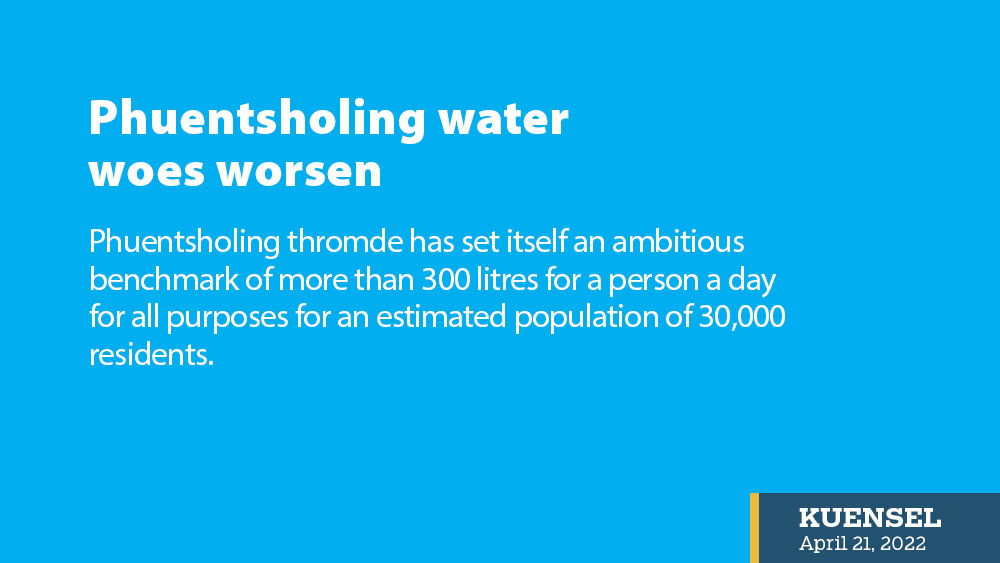Rajesh Rai | Phuentsholing
Phuentsholing thromde has set itself an ambitious benchmark of more than 300 litres for a person a day for all purposes for an estimated population of 30,000 residents.
The international standard requirement is 135 to 150 litres per person a day for all purposes. Phuentsholing Thromde residents should have surplus water. However, its residents are often battling never-ending water woes.
While many areas in the town get adequate and continuous water supply, many residents don’t.
A house owner in Pipal Dara has been running from pillar to post to find what happened to the supply in the locality.
“This has never happened before,” he said, adding that at times water is supplied even when the tenants were out of their homes.
“When they supply, they also don’t supply at the right time. I have office goers and the water is supplied at daytime.”
These days, the owner is exploring a private source. But he wants to know what the relevant officials are doing and if the situation would improve.
With two new bore wells, Phuentsholing today has 26 bore wells and two surface water sources. Water is drawn from these sources using electric pumps. Thromde officials said that this was the problem.
A thromde official, Lobzang said there is surplus water in Phuentsholing.
“But the problem is all the sources use pump system which needs power. And when there is a power outage, there is break down of pumps causing water supply problems,” he said.
“About 99 percent of the water supply problems is because of power issues. All the sources are interconnected and all are affected if one is affected,” he said.
Phuentsholing Thrompon Uttar Kumar Rai said the pumps are not available locally. It takes time to procure them with all the procurement rules in place.
“Phuentsholing is situated on fragile land. A slight rainfall can trigger landslides and flashfloods that disrupt the power and water supply,” he said.
Thromde officials also said that staff working on the water are also those in muster roll, who are not experts. They quit their job when they start learning. It is hard to find the right workers.
Thromde officials also said excavation works due to many development projects have hampered the distribution system in the town.
A senior divisional manager with Bhutan Power Corporation (BPC) office in Phuentsholing, Chhejay Wangdi attributed power outages to heavy rainfall and windstorm.
“But we try our best to bring back the power as soon as possible and our team works beyond working hours during emergencies,” he said.
Chhejay Wangdi said even if BPC’s power is out, thromde has a generator in the main water pump, which acts as a standby.
Thromde’s dedicated transformer was damaged during mid-2020. “After that, we arranged interim power supply from Amochhu temporary shelter substation. They still use power from this substation.”
If this transformer is replaced or restored, thromde can still use the water pump with the standby generator, even if BPC’s main grid supply is out.
Meanwhile, Phuentsholing residents have seen water supply shortages even during peak seasons.
A corporate employee in Dhamdara said despite continuous problems her house owner manages.
“I think she asks for water tanker vehicles,” she said. “But whatever the problem is, somebody has to take responsibility and solve it.”
A town resident, Phub Tshering said it has been “donkey years” Phuentsholing town has faced water problems.
“Whenever we call, they say some pieces of equipment are damaged. If that’s the case, thromde has to keep stock of such equipment,” he said, adding Phuentsholing has seen water problems even before the pandemic.
“And it continues today. Even god is generous as it keeps on raining but thromde water supply is just not there,” he said.
Amochhu temporary settlement residents also didn’t have water supply recently after the windstorm damaged electricity poles. However, sources said the supply has been restored.
Meanwhile, Phuentsholing Thromde has two mega projects underway. Omchu water treatment plant at Khareyphu will supply 1 million litres per day (MLD). It will be commissioned for testing around the end of this month.
Barsachu water treatment plant has a capacity to provide 3MLD per day and is expected to complete by October this year.
The largest one in the pipeline is Toorsa treatment plant, which will have 8MLD. However, it has been temporarily deferred.


